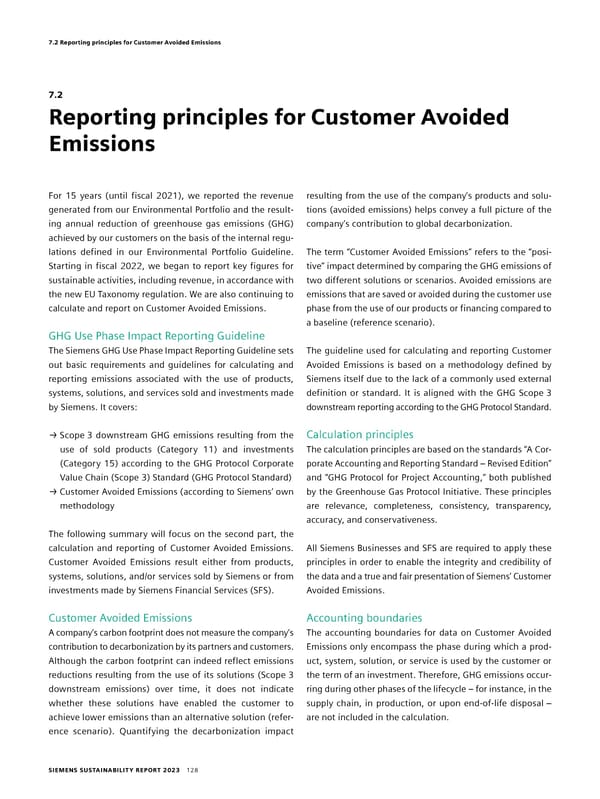7.2 Reporting principles for Customer Avoided Emissions 7.2 Reporting principles for Customer Avoided Emissions For 15 years (until fiscal 2021), we reported the revenue resulting from the use of the company’s products and solu- generated from our Environmental Portfolio and the result- tions (avoided emissions) helps convey a full picture of the ing annual reduction of greenhouse gas emissions (GHG) company’s contribution to global decarbonization. achieved by our customers on the basis of the internal regu- lations defined in our Environmental Portfolio Guideline. The term “Customer Avoided Emissions” refers to the “posi- Starting in fiscal 2022, we began to report key figures for tive” impact determined by comparing the GHG emissions of sustainable activities, including revenue, in accordance with two different solutions or scenarios. Avoided emissions are the new EU Taxonomy regulation. We are also continuing to emissions that are saved or avoided during the customer use calculate and report on Customer Avoided Emissions. phase from the use of our products or financing compared to a baseline (reference scenario). GHG Use Phase Impact Reporting Guideline The Siemens GHG Use Phase Impact Reporting Guideline sets The guideline used for calculating and reporting Customer out basic requirements and guidelines for calculating and Avoided Emissions is based on a methodology defined by reporting emissions associated with the use of products, Siemens itself due to the lack of a commonly used external systems, solutions, and services sold and investments made definition or standard. It is aligned with the GHG Scope 3 by Siemens. It covers: downstream reporting according to the GHG Protocol Standard. → Scope 3 downstream GHG emissions resulting from the Calculation principles use of sold products (Category 11) and investments The calculation principles are based on the standards “A Cor- (Category 15) according to the GHG Protocol Corporate porate Accounting and Reporting Standard – Revised Edition” Value Chain (Scope 3) Standard (GHG Protocol Standard) and “GHG Protocol for Project Accounting,” both published → Customer Avoided Emissions (according to Siemens’ own by the Greenhouse Gas Protocol Initiative. These principles methodology are relevance, completeness, consistency, transparency, accuracy, and conservativeness. The following summary will focus on the second part, the calculation and reporting of Customer Avoided Emissions. All Siemens Businesses and SFS are required to apply these Customer Avoided Emissions result either from products, principles in order to enable the integrity and credibility of systems, solutions, and/or services sold by Siemens or from the data and a true and fair presentation of Siemens’ Customer investments made by Siemens Financial Services (SFS). Avoided Emissions. Customer Avoided Emissions Accounting boundaries A company’s carbon footprint does not measure the company’s The accounting boundaries for data on Customer Avoided contribution to decarbonization by its partners and customers. Emissions only encompass the phase during which a prod- Although the carbon footprint can indeed reflect emissions uct, system, solution, or service is used by the customer or reductions resulting from the use of its solutions (Scope 3 the term of an investment. Therefore, GHG emissions occur- downstream emissions) over time, it does not indicate ring during other phases of the lifecycle – for instance, in the whether these solutions have enabled the customer to supply chain, in production, or upon end-of-life disposal – achieve lower emissions than an alternative solution (refer- are not included in the calculation. ence scenario). Quantifying the decarbonization impact SIEMENS SUSTAINABILITY REPORT 2023 128
 Sustainability Report Page 127 Page 129
Sustainability Report Page 127 Page 129